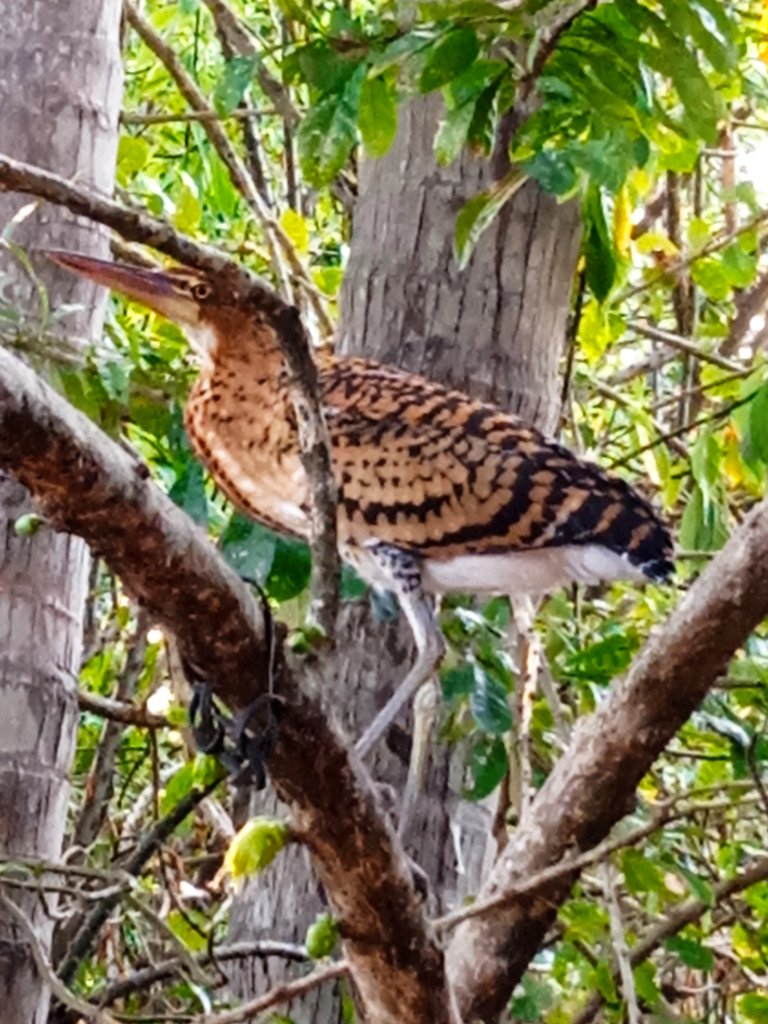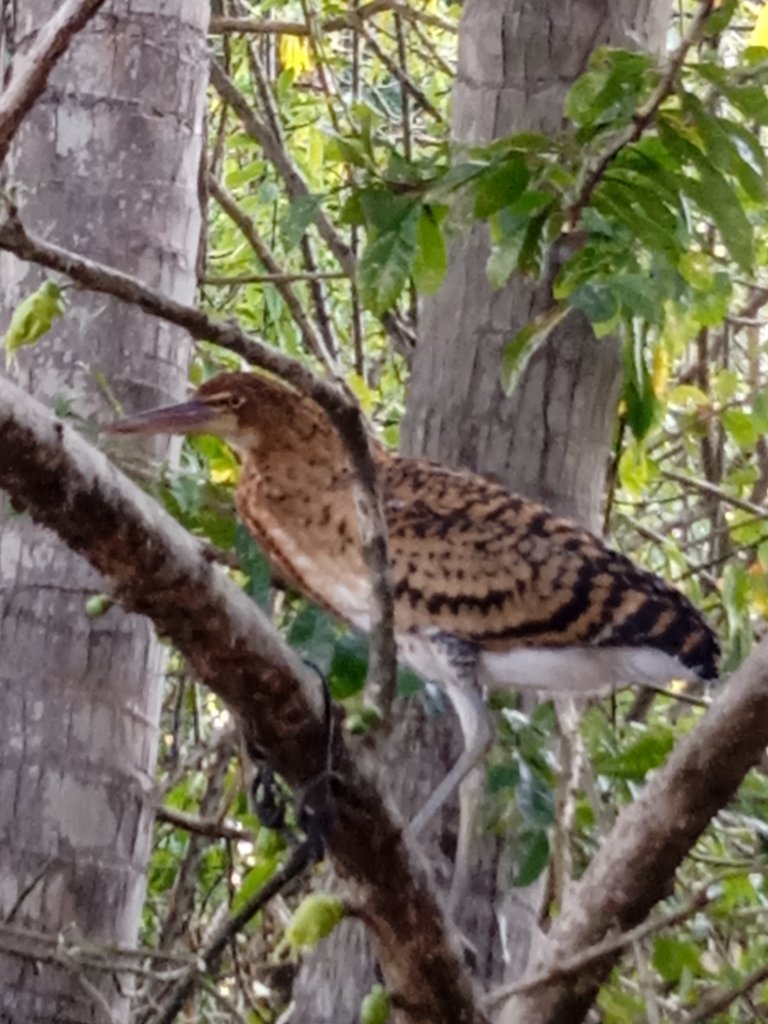Show Me A Photo Contest Round 168 | The tiger bird that moos

Puedes leer la versión en español AQUI
Good morning friends, for the first time I join this initiative of @nelinoeva which has been a great learning experience for me. It is a great activity that helps us to know our wild birds and other birds around the world.
In my case, motivated by the activity I remembered that I had a photo of a bird that arrived at my mom's house in January. It is a very particular bird because both its colorful and the songs they emit distinguish it from the rest.
It is the Rufescent Tiger Heron whose scientific name is Tigrisoma lineatum a type of heron of the family Ardeidae. Being of the order Pelecaniformes it has the shape of a pelican and feeds on fish and insects. Its scientific name comes from the color of its plumage when it is young, which resembles that of a tiger, later when it is an adult its plumage changes to a grayish and reddish tone.
It is usually found near rivers and forests near rivers, lagoons and streams, it has a medium threat of extinction because its natural habitat is being displaced by urban locations. And I think this is the reason why I have seen it on two occasions in trees of the houses where I live.
I have an anecdote about this bird, a few years ago it appeared in the house where I lived located in an urban area, the bird woke us up every day at 5 am because it began to sing loudly, only that its song was like the mooing of a cow. It was a little loud to be honest. That is why in my country Venezuela, its common name is Pájaro Vaco.
While I didn't like that tormenting sound, my mom did, she says she enjoys listening to the trill of this bird, even when she lived in the country she raised one since it hatched and it roamed her yard very quietly with the chickens. But she was warned to be careful because its pointed beak could cause harm to the children. So she got him used to being in the trees and soon he migrated.
The good thing of all is that with this bird we have free alarm and without worrying about programming it. 😃 Actually it is a bird that remains harmless and its coloring is very beautiful.
With this photo I am participating in the photo contest "Feathered Friends - Show Me a Photo Contest Round 168", you can know the rules of the contest here.
The photo was taken in Apure state, southern Venezuela.

✨Credits:✨
The content is my authorship, the images are my own and the digital editing has been done by me. The original text has been written in Spanish and translated using www.DeepL.com

Show Me A Photo Contest Round 168 | El ave tigre que muge.
Buenos días amigos, por primera vez me uno a esta iniciativa de @nelinoeva la cual ha sido para mí de gran aprendizaje. Es una gran actividad que nos ayuda a conocer nuestras aves silvestres y demás aves del mundo entero.
En mi caso, motivada por la actividad recordé que tenía una foto de un ave que llegó a la casa de mi mamá en el mes de enero. Es un ave muy partícular ya que tanto su colorido y los cantos que emiten lo distinguen del resto.
Se trata del Rufescent Tiger Heron cuyo nombre científico es
Tigrisoma lineatumun tipo de garza de la familiaArdeidae.Por ser de la orden Pelecaniformes tiene forma de pelícano y se alimenta de peces e insectos. Su nombre científico viene del color de su plumaje cuando está joven que se asemeja al de un tigre, posteriormente cuando es adulto su plumaje cambia a un tono grisáceo y rojizo.Suele encontrarse cerca de ríos y bosques cercanos a ríos, lagunas y arroyuelos, tiene una amenaza media de extinción debido a que su hábitat natural está siendo desplazado por localidades urbanas. Y creo que esta es la razón por la que lo he visto en dos oportunidades en árboles de las casas donde habito.
De esta ave tengo una anécdota, hace unos años apareció en la casa donde vivía ubicada en una zona urbana, el ave todos los dias a las 5 am nos despertaba porque comenzaba a cantar fuerte, solo que su canto era como el mugir de una vaca. Era algo estruendoso sinceramente. Por eso en mi país Venezuela, su nombre común es Pájaro Vaco.
Mientras a mí no me gustaba ese sonido atormentador, a mi mamá si le gustaba, ella dice que disfruta escuchar el trino de esta ave, incluso cuando ella vivía en el campo crio uno desde que salió del huevo y rondaba su patio muy tranquilo con las gallinas. Pero la alertaron que tuviera cuidado ya que por su pico puntiagudo podía causarle mal a los niños. Así que fue acostumbrandolo a que estuviera en los árboles y al poco tiempo emigró.
Lo bueno de todo es que con esta ave tenemos alarma gratis y sin preocuparnos por programarla. 😃 En realidad es un ave que se mantiene inofensiva y su colorido es muy hermoso.
Con esta foto estoy participando en el concurso fotográfico “Feathered Friends — Show Me a Photo Contest Round 168”, pueden conocer las reglas del concurso aquí.
La foto fue tomada en el estado Apure, al sur de Venezuela.
✨Créditos:✨
El contenido es de mi autoría, las imágenes son propias y la edición digital ha sido realizada por mí. El texto original ha sido escrito en español y traducido utilizando www.DeepL.com


Welcome to #SMaP!
What an interesting bird and story, I really enjoy reading how the bird is like an alarm clock, 😀
Thank you @nelinoeva it is a non-failing alarm 😃
Very nice observation.
I knew it from books about South America and always wanted to see it. I did in Brazil in the Pantanal.
https://www.inaturalist.org/observations/78549746
Yes, it's a very beautiful heron. Thanks for stopping by 🤗
@sagarkothari88 reward 0.05 HP
👏 Keep Up the good work on Hive ♦️ 👏
🙏 Don't forget to Support Back 🙏
Thank you for your support @hivecurators @sagarkothari88 🤗
@alborhada, you are most welcome!
Please Support Back
Here is !ALIVE token gift for you
Here is !LUV token gift for you
Here is !PIZZA token gift for you
Here is !BEER token gift for you
Thank you for supporting this contest 🤗
$PIZZA slices delivered:
@hivecurators(1/5) tipped @alborhada
Thanks for that pizza 🍕 😊.
I have never seen this kind of bird. It looks like something prehistoric. Beautiful!
Yes, it can be. It's an enigmatic bird 😅